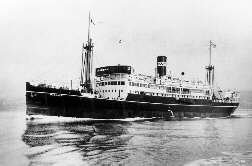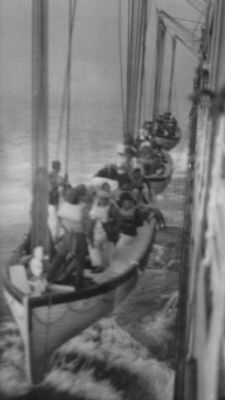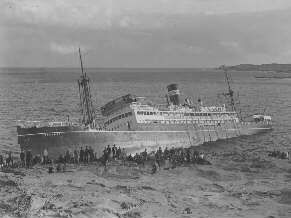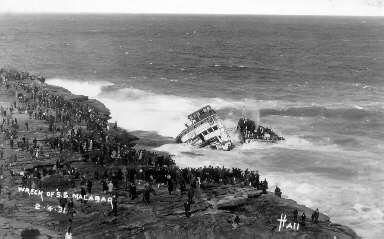
on the Firth of Clyde, Scotland
The motorship Malabar, Port of Registry, London, Official Number 148681, of 4,512 tons gross register, George William Leslie, Master, left Melbourne on 31 March 1931 with a complement of 109 officers and crew and 28 passengers, on a voyage to Singapore, with Sydney, New South Wales, as the first port of call.
 |
| The Malabar during trials on the Firth of Clyde, Scotland |
The story of the wrecking of the Malabar really begins in the early 1920s when the economic advantages of the motorship over the steamship became more obvious. The increased cargo capacity caused by the absence of coal bunkers alone was enough to justify shipowners to bring into service diesel powered motorships. The Australian shipping line Burns, Philp & Company Limited placed an order in 1924 for such a vessel, its first, to replace the Montoro on the Java to Singapore run. The new vessel was launched from the West shipbuilding yard of Barclay, Curle and Company, Scotstoun, Glasgow, Scotland on 9 July 1925.
 |
| The Malabar passes under the incomplete Sydney Harbour Bridge while leaving Sydney Harbour |
Accommodation was provided for 156 passengers in one, two and four berth cabins. There were five cargo holds as well as insulated holds for carrying fruit and frozen meat. The total cargo capacity of the Malabar was 202,920 cubic feet. Six hundred and two tons of oil could be carried in the two oil bunkers and the double bottom tank. As can be seen from these figures, the Malabar was a fairly substantial ship.
 |
| Three lifboats from the Malabar about to be
launched Note the fog |
On 10 October 1925 the Malabar was taken over by Burns Philp's London Branch and left Avonmouth on 17 October 1925 for Australia via Colombo (Sri Lanka) and Singapore. She was carrying 2,188 tons of cargo as well as 17 passengers. The Malabar arrived in Sydney on 17 December 1925 on its maiden voyage. It was the pioneer motorship to operate on the east coast of Australia and became the second motorship in Australia. The first voyage of the Malabar on the Singapore run commenced from Sydney on 2 January 1926 with a full load of cargo and a large number of passengers. The voyage was via Brisbane, Townsville, Thursday Island, Darwin, Sourabaya, Smarang and Batavia (Djakarta) on Java, now part of Indonesia. The Malabar's regular service was from Singapore to Melbourne via the above ports, with a visit to Port Moresby in New Guinea once every three to four months.
The crew of the Malabar was a varied lot. The cooks were Chinese, the cleaners and engine room staff Indian, the deck hands Malay and the officers, of course, whites.
In September 1926 the Malabar attempted to tow the stranded British tramp steamer Rio Claro off Scott Reef, about 48 kilometres south east of Cairns but was unsuccessful. The Rio Claro was still aground when the Malabar passed by on its return trip and remained there for 39 days before being refloated. In the photograph above right, the MV Malabar passes under the Sydney Harbour Bridge on 4 December 1930.
In February 1929 Burns Philp came to an agreement for a five year mail contract for the Pacific Islands with the Australian Government. This took effect in April 1929. As part of the agreement, the company agreed to build a new vessel for the Singapore run within three years and planned to move the MV Malabar to the Sydney to Rabaul (in then New Guinea) run. However, before this new vessel (MV Macdhui - to be later sunk by Japanese planes in Port Moresby Harbour) came into service on May 1931, an accident to the Malabar would change the company's plans.
 |
| The Malabar soon after hitting the rocks at Long Bay |
On 31 March 1931, the MV Malabar, under the command of Captain Leslie, set sail from Melbourne for the regular trip to Singapore. This was to be her 32nd trip. At about 6.35 am on 2 April 1931, the Malabar passed Cape Baily near Cronulla, about 25 kilometres south of Sydney Harbour. Its course was 18° magnetic and the Cape was three-quarters of a mile distant. At about 6.45 am it was one mile abeam of Cape Banks, the northern headland of Botany Bay. The weather became hazy and the course of the Malabar was said to have been altered to 23 degrees magnetic. Shortly after the vessel entered a dense fog and at 6.52 am it ran aground on the northern side of Long Bay, about 14 kilometres south of the Harbour. Photographs taken later that day show the seas to be absolutely millpond, although reports in the Sydney Morning Herald the next day state that at high tide the swell became more pronounced. I have recently (early 2004) came across some photos taken on the ship after it had hit the rocks. These clearly show that there was quite a lot of fog around.
 |
| The Malabar on 2 April 1931 |
The Captain, three officers and the doctor stayed aboard the Malabar until noon and then they stood by in a small boat until 1.30 pm when it had developed a critical list to starboard. The ship was filling up and submerging aft.
"There were two principal places of amusement (in Sydney) on the Good Friday holiday - the (Royal Easter) Show and the Malabar - and it appeared that everyone went to both" said the Sydney Morning Herald on 4 April 1931. The newspapers of the day state that huge crowds of people came out to see the new wreck and photographs of the complete ship show people all over the headland and rock platform. The Daily Telegraph and the Herald reported that on 4 April, Good Friday, 150,000 people visited the site of the wreck. The ship had completely broken up earlier that day in heavy seas and the cargo was washed into the sea. The newspaper reports tell stories of people salvaging goods from the coastline between Sydney and Newcastle and even in Sydney Harbour. The Herald reported some young men who risked their lives to get a keg of beer out of the sea near the wreck.
 |
| The wreck the day after hitting Long Bay - 3 April 1931 |
On 5 April a snake charmer, George Aither of Surry Hills, was bitten on the hand by one of his snakes while performing at the wreck site. He was taken to the nearby Coast (Prince Henry) Hospital where he was treated and later released. On 6 April two men were arrested after stealing the ship's compass. Bruce William Tilley appeared in Central Police Court on 20 April charged with stealing the compass, value £90 and was released on £30 bail. It was not reported what happened to the accomplice or what was the outcome of the case against Tilley.
Another very interesting story concerns the crew of the ship. Apparently some of the Chinese crew were smuggling opium into Australia. The Police had learnt of this and were waiting at the wharf for them. When news came of the stranding, they rushed to Long Bay. Here they followed one of the Chinese crew and 10 days later, on 12 April 1931, the Police raided a Dixon Street (Chinatown) opium den. Here they smashed down a brick wall and found 16 cans of opium. Among the Chinese arrested were three of the Malabar's crew. It is not reported what happened to them.
The wreck was sold for £140 and the cargo for £41 to the Penguin Salvage Co. on 7 April 1931. It is interesting to note that the wreck of the SS Minmi was purchased by Penguin Ltd in 1937 and the hulk of the Meggol (ex HMAS Doomba) in 1947. Salvage started on 8 April and the binnacle stand, some furniture and basins were removed but work was suspended on 9 April due to heavy seas. The Union Jack and boson's store were rescued on 10 April. The Sydney Morning Herald reported on 16 April that a diver was in extreme peril on the sea floor at Long Bay the previous day. Some fishermen had secured a diving suit and were searching for goods when the safety line was lost and the diver "walked helplessly about the bay". Eventually he removed his weighted boots and shot feet first to the surface. He was not injured.
After these salvage attempts, the wreck lay basically untouched for over 25 years until the introduction of scuba. In the late 1950s and early 1960s some of the pioneer divers in the Sydney area dived on the wreck and salvaged the valuable metal items that remained. Barry May blew the remains up in his attempt to salvage remains. Together with John Bissett, he salvaged the prop sometime prior to 1962. This was 15 foot 6 inches across and had to be broken up before they could move it. The total weight was estimated at six tons, all bronze!! The boss alone was 2.5 tons.Pieces such as the bell (taken in 1961 by Sydney diver Jon Jacobs and still owned by him) and other valuable momentos' were also taken during this time. Another bell was also recovered during the salvage in the days after the sinking. It was purchased by the father of Richmond farmer Bob Power at a sale of items salvaged from the wreck. Inscribed "Malabar 1926", it was passed on to Mr Power but was stolen in late 1990 from the veranda of his farmhouse. This must have been installed after the ship arrived in Australia.
The relatively shallow depth that the wreck is in and the fact that the site is totally open to the worst seas that afflict Sydney have meant, together with May's efforts, that the hull, deck and superstructure of the Malabar are now nothing but rusted and twisted pieces of metal. However, this does not mean that the wreck is not worth visiting.
Then, just when scuba diving became more available to the general public, the site became virtually inaccessible to divers.
Unfortunately, the Malabar happened to be not only located right next to Sydney's largest sewage treatment plant, but within metres of the ocean outfall. This meant that the (basically) untreated sewage was being dumped straight into the sea next to the wreck. Not only did it make the wreck site undiveable, but it affected Long Bay to such an extent that the NSW Health Department and Randwick Council closed Malabar Beach and a nearby ocean pool in the mid-1960s because of the extreme pollution.
On 22 September 1990, the Malabar Sewage Treatment Plant deep-water ocean outfall system was activated. The opening of this outfall, the first of three under construction for Sydney's major sewage treatment plants, marked the beginning of the end of a 202 year policy of dumping sewage directly into the water off Sydney's shoreline. The new outfall deposits the partially treated sewage 3 to 4 kilometres off-shore in deep water. It also represented the first stage in a long term upgrading strategy for the disposal of sewage in Sydney.As simple as this change was, it produced immediate results. Within hours of being switched on, the water around the old outfall at Yellow Rock was dramatically clearer. After having lived near the sewage treatment plant nearly all my life, it was apparent to me within one day that the water quality in the ocean and adjacent Long Bay had improved to such a degree that swimming and diving would be a healthy pursuit to undertake in the bay.
The wrecking of the Malabar will forever be remembered in Sydney's history, as the suburb of Long Bay was renamed Malabar after the ship. The name was adopted sometime after the wrecking, but it was not until June 1977 that the NSW Geographical Names Board officially approved Malabar for the suburb. The name Malabar lives on not only in the of the Sydney suburb, but in this easily accessible dive for all divers.
The Court found the charge proved and cancelled the Certificate of George Leslie.
References:
Extracts from Michael McFadyen